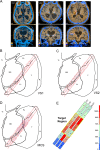Single unit activities recorded in the thalamus and the overlying parietal cortex of subjects affected by disorders of consciousness
- PMID: 30403761
- PMCID: PMC6221278
- DOI: 10.1371/journal.pone.0205967
Single unit activities recorded in the thalamus and the overlying parietal cortex of subjects affected by disorders of consciousness
Abstract
The lack of direct neurophysiological recordings from the thalamus and the cortex hampers our understanding of vegetative state/unresponsive wakefulness syndrome and minimally conscious state in humans. We obtained microelectrode recordings from the thalami and the homolateral parietal cortex of two vegetative state/unresponsive wakefulness syndrome and one minimally conscious state patients during surgery for implantation of electrodes in both thalami for chronic deep brain stimulation. We found that activity of the thalamo-cortical networks differed among the two conditions. There were half the number of active neurons in the thalami of patients in vegetative state/unresponsive wakefulness syndrome than in minimally conscious state. Coupling of thalamic neuron discharge with EEG phases also differed in the two conditions and thalamo-cortical cross-frequency coupling was limited to the minimally conscious state patient. When consciousness is physiologically or pharmacologically reversibly suspended there is a significant increase in bursting activity of the thalamic neurons. By contrast, in the thalami of our patients in both conditions fewer than 17% of the recorded neurons showed bursting activity. This indicates that these conditions differ from physiological suspension of consciousness and that increased thalamic inhibition is not prominent. Our findings, albeit obtained in a limited number of patients, unveil the neurophysiology of these conditions at single unit resolution and might be relevant for inspiring novel therapeutic options.
Conflict of interest statement
The authors have declared that no competing interests exist.
Figures





Similar articles
-
Results of a prospective study (CATS) on the effects of thalamic stimulation in minimally conscious and vegetative state patients.J Neurosurg. 2016 Oct;125(4):972-981. doi: 10.3171/2015.7.JNS15700. Epub 2016 Jan 8. J Neurosurg. 2016. PMID: 26745476
-
Spatially Overlapping Regions Show Abnormal Thalamo-frontal Circuit and Abnormal Precuneus in Disorders of Consciousness.Brain Topogr. 2019 May;32(3):445-460. doi: 10.1007/s10548-018-0693-0. Epub 2019 Feb 1. Brain Topogr. 2019. PMID: 30707390
-
Degrees of functional connectome abnormality in disorders of consciousness.Hum Brain Mapp. 2018 Jul;39(7):2929-2940. doi: 10.1002/hbm.24050. Epub 2018 Mar 25. Hum Brain Mapp. 2018. PMID: 29575425 Free PMC article.
-
Brain function in the vegetative state.Acta Neurol Belg. 2002 Dec;102(4):177-85. Acta Neurol Belg. 2002. PMID: 12534245 Review.
-
Assessing consciousness in coma and related states using transcranial magnetic stimulation combined with electroencephalography.Ann Fr Anesth Reanim. 2014 Feb;33(2):65-71. doi: 10.1016/j.annfar.2013.11.002. Epub 2014 Jan 6. Ann Fr Anesth Reanim. 2014. PMID: 24393302 Review.
Cited by
-
Thalamic burst and tonic firing selectively indicate patients' consciousness level and recovery.Innovation (Camb). 2025 Feb 25;6(5):100846. doi: 10.1016/j.xinn.2025.100846. eCollection 2025 May 5. Innovation (Camb). 2025. PMID: 40432773 Free PMC article.
-
Thalamus and consciousness: a systematic review on thalamic nuclei associated with consciousness.Front Neurol. 2025 Jun 18;16:1509668. doi: 10.3389/fneur.2025.1509668. eCollection 2025. Front Neurol. 2025. PMID: 40642212 Free PMC article.
-
The Arousal-Related "Central Thalamus" Stimulation Site Simultaneously Innervates Multiple High-Level Frontal and Parietal Areas.J Neurosci. 2023 Nov 15;43(46):7812-7821. doi: 10.1523/JNEUROSCI.1216-23.2023. Epub 2023 Sep 27. J Neurosci. 2023. PMID: 37758474 Free PMC article.
-
[Current progress on characteristics of intracranial electrophysiology related to prolonged disorders of consciousness].Sheng Wu Yi Xue Gong Cheng Xue Za Zhi. 2024 Aug 25;41(4):826-832. doi: 10.7507/1001-5515.202403023. Sheng Wu Yi Xue Gong Cheng Xue Za Zhi. 2024. PMID: 39218610 Free PMC article. Review. Chinese.
-
Revolutionizing treatment for disorders of consciousness: a multidisciplinary review of advancements in deep brain stimulation.Mil Med Res. 2024 Dec 18;11(1):81. doi: 10.1186/s40779-024-00585-w. Mil Med Res. 2024. PMID: 39690407 Free PMC article. Review.
References
-
- Giacino JT, Ashwal S, Childs N, Cranford R, Jennett B, Katz DI, et al. The minimally conscious state: definition and diagnostic criteria. Neurology. 2002;58: 349–353. - PubMed
Publication types
MeSH terms
LinkOut - more resources
Full Text Sources

